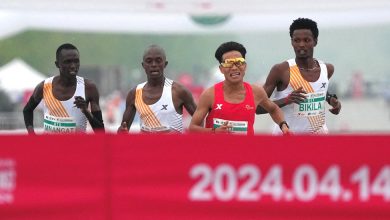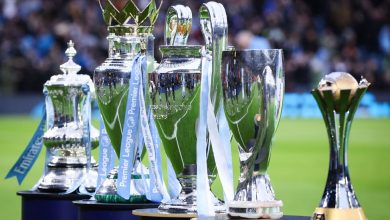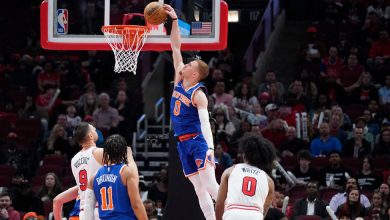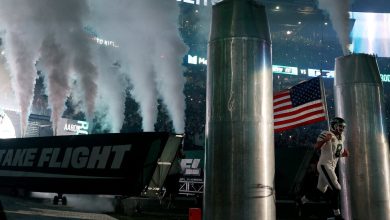At Wimbledon, American Men Are Putting on a Fourth of July Bash




Taylor Fritz, left, Francis Tiafoe and Tommy Paul, are three of eight American men ranked in the top 50. Credit…Shaun Botterill/Getty Images; Clive Brunskill/Getty Images; Justin Setterfield/Getty Images
WIMBLEDON, England — Just in time for the Fourth of July weekend, the American men are throwing a party on British soil.
As night fell on Thursday at the All England Club, eight American men were set to qualify for the third round of the prestigious Wimbledon tournament, accounting for 25 percent of the final 32 spots. That is the most American men in the third round at the event since 1995, when nine qualified in the Sampras-Agassi-Courier-Chang heydays. It also the most in any Grand Slam tournament since the U.S. Open in 1996.
Nearly everywhere one looked on Wednesday and Thursday, an American man was slamming or slicing or grinding his way into the final 32, and one more will clinch his spot Friday. The sun has seemingly set on the era when every male American player had a big serve and a forehand and not much else.
Some were familiar faces, like John Isner, bashing his way past the hometown favorite Andy Murray. But several were part of the next wave of rising Yanks in their mid-20s — the clique of Taylor Fritz, Tommy Paul and Francis Tiafoe that first bonded as teenagers at a national training center in Florida. And then there were a couple from the wave after that (Jenson Brooksby and Brandon Nakashima) who are still a couple years away from needing a daily shave. Two Americans, Maxime Cressy and Jack Sock, one new to the scene, the other a veteran, were dueling for the last available spot until rain interrupted their match on No. 3 Court on Thursday.

Brandon Nakashima won his second-round match against Denis Shapvalov of Canada on Thursday.Credit…Toby Melville/Reuters
“It’s been a long, long progression,” said Martin Blackman, the former pro who is the general manager of player development for the United States Tennis Association.
Now before anyone stateside rushes out to the liquor store to get some Pimm’s on ice for a championship celebration, it is worth noting that no one expects any of these players to actually win the men’s singles title, at least not this year. American men’s tennis is deep but light on the top.
The U.S. now has eight men in the top 50 and 13 in the top 100, more than any other country. Arguably the most promising of the lot, Sebastian Korda, son of the former world No. 2 Petr Korda, had to withdraw from Wimbledon 10 days ago with shin splints.
Didn’t give me anything to fish for,” Denis Shapovalov of Canada said of Nakashima, who beat him in four sets Thursday.
Despite the stampede this week, there are no Americans in the top 10 and just two in the top 20 — Fritz and Reilly Opelka. Russia and Spain each have two players in the top 10. Spain, the best tennis country of the last decade, has four players in the top 20.
But for a country whose male talent stock has long been seen as fairly lacking and is without a Grand Slam tournament champion since Andy Roddick won the U.S. Open in 2003, depth represents significant progress. It also serves as a kind of motivational tool. A friendly competition has emerged between the Americans in their mid-20s, who are led by Fritz, and the ones who have just reached the legal drinking age in the United States, or are not there yet, to be the first to play into the final rounds of a Grand Slam tournament.
“They’re great for us,” Paul, 25, said of Brooksby, Korda, both 21, and Nakashima, 20. “They push us.”
“For tennis to grow, we’re going to need some winners on the men’s side,” he added.
The U.S.T.A. knows that as well. For years, it has been trying to hone a system to help develop players that will work in a vast country with more than 330 million people and plenty of competition from more popular sports that are cheaper for good young athletes to pursue.
In Europe, especially, Eastern Europe, young teenagers with promise often leave home for academies. The academic and psychological support can be thin. A “Lord of the Flies,” sink-or-swim environment persists. Despite its success there in producing some formidable talent and champions, including Novak Djokovic, that model was never going to work with American parents.
Instead, over the last decade the organization has tried to create a trout farm rather than find a unicorn. It developed a three-tiered program of local, regional and national camps that bring together top talent throughout the year but also allow kids to stay home for as long as possible and work with their own coaches. Airfare to the camps isn’t included, but just about everything else is, even some money for private coaches to attend sometimes so they don’t feel squeezed out of the process as a young player gets older and better.
There is no one-size-fits-all approach. During the crucial years of development between the ages of 15 and 22, some players choose to work with U.S.T.A. coaches and trainers at their training centers in Orlando, Fla., or Carson, Calif., outside Los Angeles. Fritz was a part of the U.S.T.A. program for six years, Paul for five, Opelka for four and Tiafoe for three, Blackman said.
Others, such as Korda, Nakashima and Brooksby, choose to remain largely outside the system, but they still can qualify for financial support and come to the occasional camp or show up at the training center for competition.
Blackman also does not want the organization to preach a certain style of play. Cressy’s serve-and-volley game is just as valued as Brooksby’s finesse, Tiafoe’s serve-and-forehand power, and Nakashima’s all-court approach.
At one such camp, a national gathering in Boca Raton, Fla., a decade ago, Fritz, Paul, and Tiafoe first bonded.
“It was just really boring in those dorms, nothing to do, so we didn’t have much choice,” Fritz said recently.
Fritz, with his big feet and mop of hair, and the least advanced game of the group, quickly became the group punching bag, friendly punching of course.
“Big, goofy guy like that, you know he was going to end up being the target,” Tiafoe said.
Paul said Fritz took it well. Fritz also saw that members of his new clique were better at tennis than he was, and he began working harder to catch up. Within a few years, he had pushed ahead. He is now the top-ranked American man at No. 14 and the only one of the younger set to have won a Masters 1000 tournament, the level just below the Grand Slams, emerging at Indian Wells, Calif., earlier this year.
They remain close friends and genuinely invested in each other’s success, which helps during a long season filled with travel. Paul has been on the road for nearly 10 weeks.
“I’m so homesick I want to throw up,” he said Thursday.
Text threads and group dinners, sometimes fancy, sometimes burgers and pizza and lengthy bull sessions help. Tiafoe made the final at a tournament in Portugal earlier this year. As he came off the court following each win, he would find congratulatory notes on his phone from the posse.
A big and extremely difficult task for the next generation and the one right behind them still lies ahead — getting into the top 10 and becoming fixtures in the last matches of the biggest tournaments, the way American women, led by the Williams sisters, have performed for years.
It’s getting closer.
“I expect us to do well in all of these tournaments now,” Paul said. “It’s all about winning one more match and going one round deeper.”
Paul has never made the second week of a Grand Slam. On Friday, on the first day of a third round with plenty of American company, he will get another chance.



